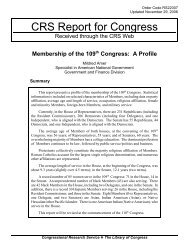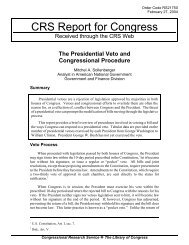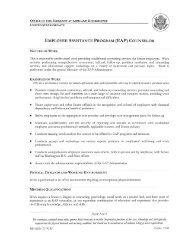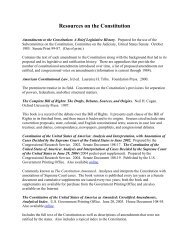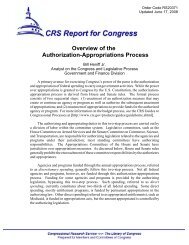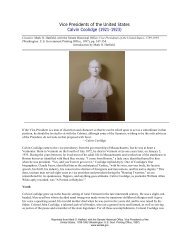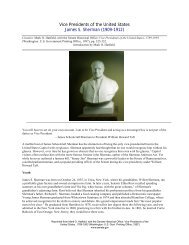The Capitol
The Capitol
The Capitol
Create successful ePaper yourself
Turn your PDF publications into a flip-book with our unique Google optimized e-Paper software.
<strong>The</strong> Congress<br />
<strong>The</strong> chief focus of the <strong>Capitol</strong> is on the chambers<br />
of the Senate and House of Representatives. Here<br />
members introduce legislation; speak out on the<br />
issues; and cast votes on bills, resolutions, nominations,<br />
and treaties. A series of buzzers and lights<br />
throughout the <strong>Capitol</strong> and office buildings summon<br />
members to vote. <strong>The</strong> House chamber is in<br />
the south wing of the <strong>Capitol</strong>; the Senate chamber<br />
is in the north wing.<br />
Galleries in both houses have been set aside for<br />
the print and broadcast media, and in recent years<br />
floor proceedings have been televised. Except<br />
on rare occasions, proceedings of the Senate and<br />
House and their committees are open to the press<br />
and public. News of congressional activities is<br />
broadcast instantly around the world from the<br />
<strong>Capitol</strong>, and visitors will often see cameras and<br />
reporters outside the building, using the <strong>Capitol</strong><br />
dome as their backdrop.<br />
years. Senators are elected for six-year terms, onethird<br />
of the Senate being elected every two years.<br />
Originally senators were chosen by state legislators,<br />
but in 1913 the Seventeenth Amendment provided<br />
for direct election of senators by the people.<br />
If a senator dies or leaves office in midterm, the<br />
governor of the state may appoint a replacement.<br />
<strong>The</strong> vice president is the presiding officer of the<br />
Senate, but on a daily basis the chair is usually held<br />
by the president pro tempore of the Senate (the<br />
senior member of the majority party) or a designee.<br />
<strong>The</strong> vice president votes only to break a tie.<br />
<strong>The</strong> House of Representatives<br />
<strong>The</strong> House of Representatives, under a law passed<br />
in 1911, is limited to 435 members. States are<br />
assigned a number of representatives based on<br />
their population and are redistricted every ten<br />
years after the census. Each state is entitled to at<br />
<strong>The</strong> Senate<br />
<strong>The</strong> Senate has 100 members, two from each state.<br />
A senator must be thirty years of age, a resident of<br />
the state, and a citizen of the United States for nine<br />
<strong>The</strong> chamber of the House of Representatives.<br />
<strong>The</strong> Senate chamber.<br />
least one representative. If a representative dies or<br />
leaves office in midterm, a special election is held<br />
to choose a replacement. In addition, non-voting<br />
delegates represent American Samoa, the District of<br />
Columbia, Guam, and the Virgin Islands; Puerto Rico<br />
is represented by a resident commissioner.<br />
A representative must be twenty-five years of<br />
age, a resident of the state, and a citizen of the





